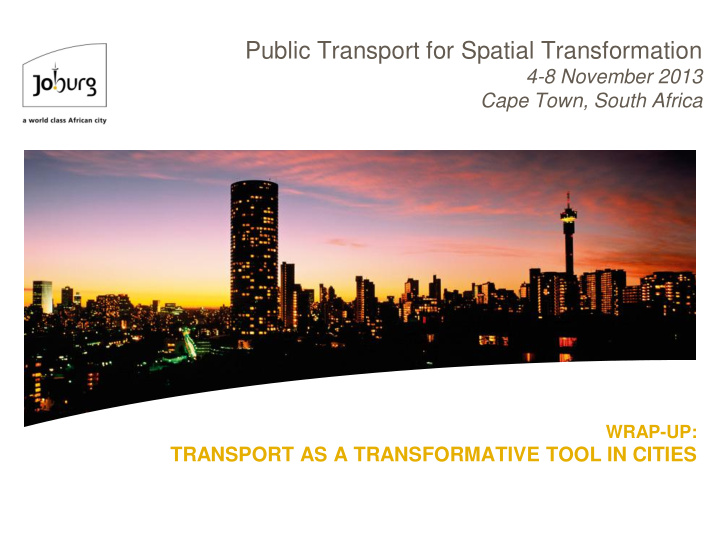



Public Transport for Spatial Transformation 4-8 November 2013 Cape Town, South Africa WRAP-UP: TRANSPORT AS A TRANSFORMATIVE TOOL IN CITIES
Context Leading the Spatial Transformation Agenda >> A distinct developmental agenda: > The Joburg GDS 2040 What we want to achieve: > Sustainable Human Settlements What needs to happen: > Places and spaces for live, work and play Overarching philosophy: > Transit Oriented Development (TOD) Making it happen: > Corridors of Freedom
Learning Journey 3
What did we learn? (1) Lessons and awareness on “contagious ideas” >> Are we building infrastructure for maximum flexibility or just relative flexibility? Don’t let the mode of transit be the primary determinant. Consider what the ‘magnets’ within the corridor are, through social capital and land values maps. Design is key, but it comes ‘later’ . Get the big picture in order first. Consider socio-cultural aspects in defining the boundary of your corridor. The normative engineering standard of 800m is not the only determinant – Also define the corridor in terms of the area of change that it will reach. Leading point: Don’t let the logistics of operational theory and design predetermine the social transformation outcome that you want. Signpost: Stakeholder engagement, collaboration and partnerships. 4
What did we learn? (2) Lessons and awareness on stakeholder engagement, partnerships and collaboration >> Pave the way by using Political Leadership to stir emotions, evoke interest and capture imagination. Understand your stakeholders and map the areas to which different negotiation strategies will need to be applied. It is paramount that community members buy into the objective. Lael Bethlehem’s insight on providing clarity , earning credibility and building alliances captures this duty succinctly. Know what your partners are looking for and be able to respond to that! We need to have a serious conversation about our public participation strategy if we are to succeed with the Corridors of Freedom. Signpost: Institutional arrangements and governance – both internal and external 5
What did we learn? (3) Lessons and awareness on institutional arrangements and governance >> Don’t overload projects with too many objectives. Doing this blurs priorities. Blurred priorities can lead to role confusion. Role confusion leads to business inefficiency. Business inefficiency makes the costs of running the business of local government expensive. Take realistic stock of what gets “de - prioritised” when more priorities are added. Create space for dialogue, both internally and externally. This allows individuals in the organisation to mature collectively. We need to stop majoring on the minors. Strengthen inter-municipal and intra- municipal dialogues and knowledge sharing. The ‘Growth Staircase’ – we need to find ourselves between Horizons 2&3, as this is the space of strategy and innovation. Signpost: Team work and leadership 6
What did we learn? (4) Lessons and awareness on leadership and teams >> As a group, we describe our interaction as ‘chilled’ . Administrative and protocol-based leadership became organic and situational leadership. Leadership is also about accountability. We need more sub-delegation so that people at the lower levels become more accountable. Leadership’s role in closing the fiscal gap through taking control of remuneration costs, reassessing business models, ramping up CAPEX. Being the conductor of the orchestra – bringing together the City’s collective institutional machinery to achieve our strategic objectives is where we have to lead 7
Assistance from National (5) Support from National … >> Allocation of CAPEX – the burden of providing the service is on the City; Bus operating subsidy – is it part of the of grant? Transformation of the taxi industry – what kind of model could we have to subsidise the taxi industry? AFC system; Multi-year capital budgeting regulations; Developmental decisions versus administrative decisions; Because we are trying to build different cities 8
What did we learn? (5) Tools and mechanisms to improve >> Land use incentives Value Capture Urban Management Info-structure Partnerships and collaboration Infrastructure designed around people 9
CAMPUS SQUARE: SITUATION Navigating the challenges to enable high density: • NIMBY • Low economic activity • Mechanisms to coerce vastly different interests and investments • Starting a revolution • Financing this investment in a low growth and long range development
Conclusion The end … of the beginning >> The cost of doing nothing is greater than the cost of doing something 11
Recommend
More recommend